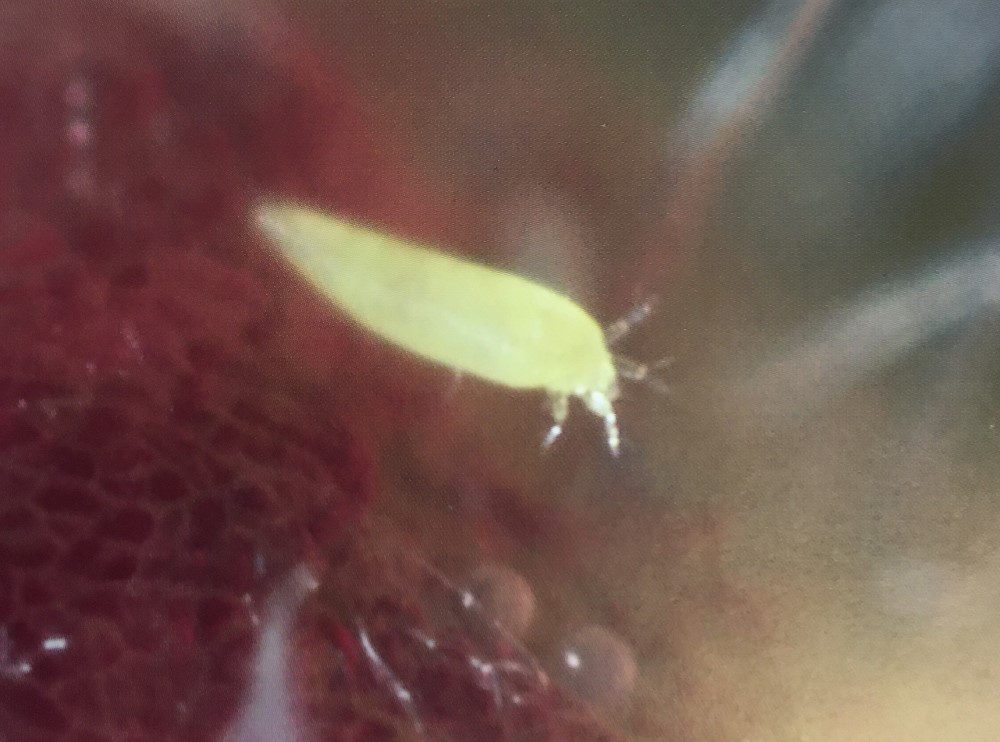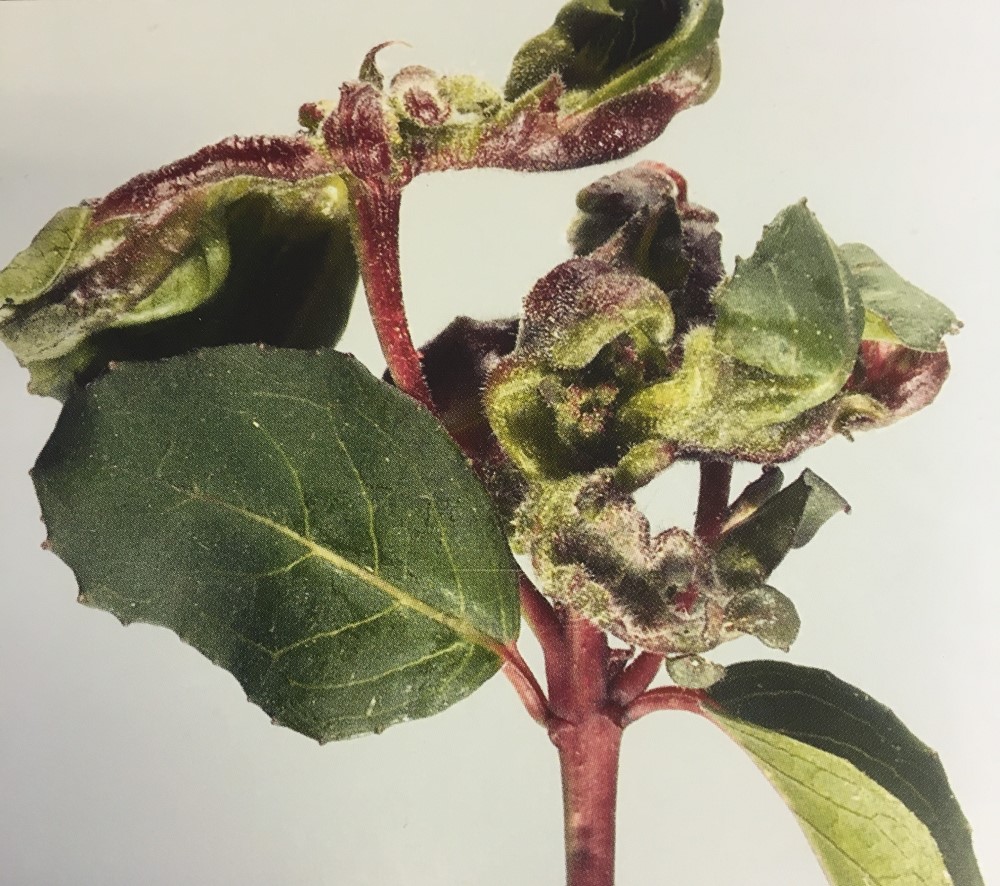Please click here to access the main AHDB website and other sectors.
- Home
- Knowledge library
- Eriophyid mites
Eriophyid mites
How to identify eriophyid pest species and their symptoms on host plants and gain an appreciation of pest biology to aid in the development of effective control strategies. This section includes details of the fuchsia gall mite (Aculops fuchsiae) and pear leaf blister mite (Eriophyes pyri).
Back to: The biology and control of mites in ornamentals
Identification and symptoms
Eriophyid mites include species of blister, bud, gall and rust mites, named after the deformities they cause. The mites are very small, cigar-shaped, translucent, yellow, pink or white, with two sets of front legs, located by the head. Species range between 0.1–0.3 mm in length and can only be seen with the aid of a x20 hand lens or greater magnification. Plant quality is reduced by feeding damage, which can lead to deformities, such as galls, erinea (felty areas of dense leaf hairs), brooms (deformed masses of twigs or branches), leaf blistering, curling, rusts and silvering. The mites disperse by travelling on the wind or riding on insects, birds or staff clothing. They seek microenvironments under bud scales, in growing points or at the petiole base of leaves.
Many eriophyids cause no detectable damage to plants and even provide a supplementary food source for predatory mites. It is important to monitor for eriophyid symptoms before the population of pest species reaches damaging numbers and, if necessary, confirm diagnosis with an entomologist or consultant. Deformities are caused by injection of salivary growth regulatory compounds into living plant tissue. Therefore, deformities can continue to form after the mites have gone. Each host plant reacts differently and symptoms vary according to the part of the plant that has been affected and the species of eriophyid causing deformity. Some eriophyid mites can coexist in communities with other species of eriophyid, resulting in unique deformities specific to the host and the eriophyid community.
Symptoms include:
Galls
Galls are the most typical symptom of damage by eriophyid mites. Galls can form on many parts of a plant, such as leaf petioles, flower buds, leaf buds and leaves, and can vary in appearance. They can be solitary or in clusters; elongate, hemispherical, rounded or bead-like; scattered irregularly or restricted by leaf veins.
Erinea
Erinea are not closed growths like galls but provide protection for the mites with a dense, abnormal, felty growth of leaf hairs, usually on the underside of the leaf.
Witches’ brooms
Witches’ brooms form when feeding damage modifies a shoot, compacting the internodes and causing a bud-like cluster of overlapping branches and leaves. Some species of eriophyid are associated with witches’ brooms caused by fungal or viral diseases.
Russeting
Rust mite feeding produces leaf and fruit discolouration and russeting.
Biology
Eriophyids have a complicated life cycle involving two types of female. In general, on deciduous hosts, the overwintered (deutogyne) female begins feeding in spring. The saliva contains growth regulatory compounds which produce plant deformities, such as a gall. The female then lays eggs within the protection of the gall, which develop into summer (protogyne) females and males. The protogyne females reproduce continually throughout the growing season, with overlapping generations every two to three weeks.
Host plants
There are more than 1,800 species of eriophyid mites. Some species are host-specific and others can affect multiple species.
For example, the tomato russet mite (Aculops lycopersicae) can cause severe damage to tomato but can also affect Petunia and overwinter on deadly nightshade. All of these species are members of the Solanaceae family.
Some of the hosts affected by eriophyid species include: Acer, Aesculus, Alnus, Amelanchier, Betula, Carpinus, Chrysanthemum, Crataegus, Cotoneaster, Cytisus, Euonymus, Fagus, Fuchsia, Fraxinus, Juglans, Malus, Populus, Prunus, Pyrus, Rhododendron, Robinia, Rosa, Salix, Sambucus, Sorbus, Syringa, Taxus, Tilia, Ulmus and Yucca.
Fuchsia gall mite (Aculops fuchsiae)
The fuchsia gall mite (Aculops fuchsia) attacks and seriously damages all but the most resistant species and cultivars of fuchsia. It is native to Brazil but has been recorded in southern England since 2007. Fuchsia gall mite used to be a notifiable quarantine pest if it occurred on commercial nurseries in the UK, but this is no longer the case.
The fuchsia gall mite is cigar-shaped, pale cream in colour and only 0.2–0.25 mm in length. Huge numbers of mites can build up in the shoots and growing points of plants. When plants are first infested, little or no damage is visible, so cutting material can be moved within the trade, unwittingly spreading the infestation. Therefore, propagators need to be aware of this pest and have their stock plants tested for it at regular intervals.
Symptoms of infestation start with reddening of the leaves at the shoot tips. Leaves and flowers become deformed or galled and growth distorted. Six fuchsia species, one subspecies and several cultivars are noted to be highly resistant to attack by this mite. The species include: F. boliviana, F. minutiflora, F. microphylla subsp. hindalgensis, F. radicans, F. thymifolia, F. tincta, F. venusta; and cultivars: ‘Baby Chang’, ‘Chance Encounter’, ‘Cinnabarina’, ‘Isis’, ‘Mendocino Mini’, ‘Miniature Jewels’, ‘Ocean Mist’ and ‘Space Shuttle’.
Close-up image of fuchsia gall mite

Image © ADAS Horticulture.
Distortion to the growing point of fuchsia as a result of the fuchsia gall mite

Image © ADAS Horticulture.
Pear leaf blister mite (Eriophyes pyri)
Although an important pest of pear, pear leaf blister mite (Eriophyes pyri) is also associated with other rosaceous hosts. The mite is small (0.2 mm), elongate and brownish in colour.
Mites start to feed on swelling buds in spring, penetrating deeper into the buds to feed and lay eggs on young leaves and blossom. Most blisters develop at this time as greenish pimples, which become yellowish blisters on the upper leaf surface. Holes appear in the blister as cells die off, and females enter to lay eggs inside the leaf. As the population increases, mites move from blister to blister. Severe infestations cause leaves to become completely reddened, swollen, blistered and folded. Spots coalesce, forming dark brown patches and may cause leaves to rip or fall. During summer, blisters dry and the mites abandon them for terminal buds to overwinter beneath the outer bud scales.
Pear leaf blister mite can affect several species of hardy nursery stock, such as Amelanchier, Chaenomeles, Cotoneaster, Crataegus, Malus, Pyrus and Sorbus.
Useful links
For more information about the fuchsia gall mite, see the Fera Plant Pest Factsheet (note: the pest is no longer a notifiable quarantine pest).
For information on the pear leaf blister mite, access the AHDB Pear Crop Walkers’ Guide
Authors
Authors – Elysia Bartel and Jude Bennison, ADAS Horticulture.
Original author (08/05 ‘The biology and control of two-spotted spider mite in nursery stock’ and 12/09 ‘The biology and control of mites in pot and bedding plants’) – John Buxton, ADAS.
Got a question? Ask a member of the team:
Web page content correct as of June 2021.
Typical leaf damage to pear as a result of pear leaf blister mite
.jpg)
Image © NIAB EMR.

